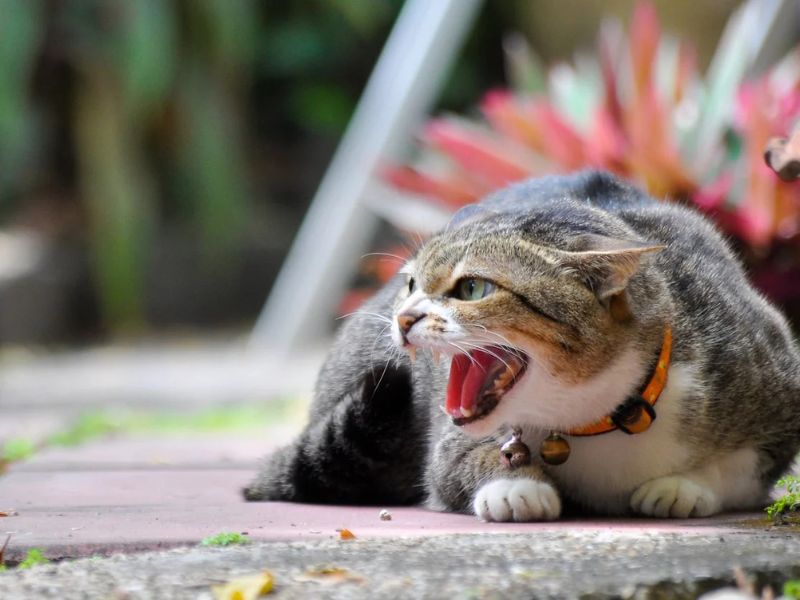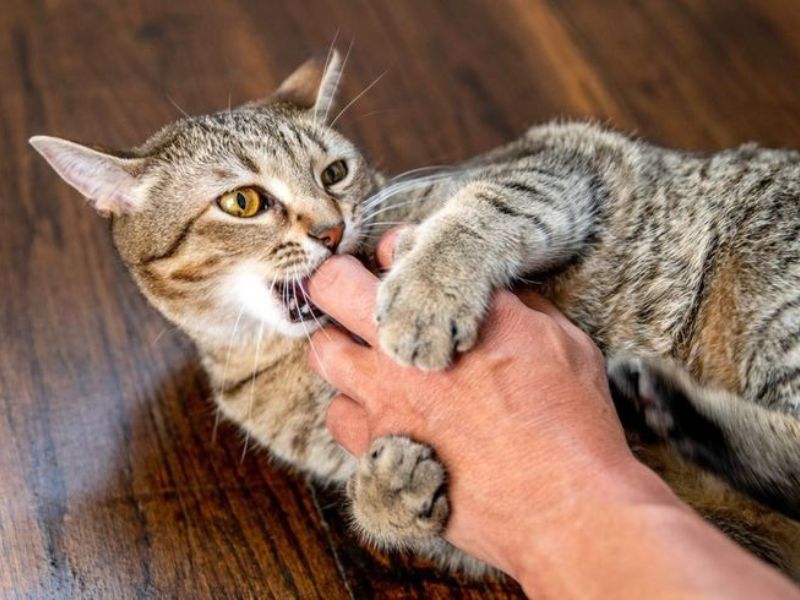Have you ever watched your cat calmly petting you and suddenly it attacks you? Or maybe you are just sitting near it and it starts biting or clawing at you? Why does a cat do this? When a cat attacks you for no apparent reason, what could be the reason behind it?
If this unusual behavior starts suddenly, it’s best to have your cat checked by a veterinarian to rule out health issues such as pain as the aggression is being caused.
Understand Your Cat is Playing or Aggressive?
It can sometimes be challenging to distinguish between a cat playing and displaying aggression. However, certain signs can help you identify the difference. When a cat is playing, it tends to be quiet and more relaxed.
On the other hand, if your cat shows aggressive behaviors such as hissing, growling, or spitting, an arched back with raised fur, ears pinned back, dilated pupils, and a tense body position with tucked legs or tail, it’s a sign of aggression, likely caused by fear or overstimulation.
Understanding your cat’s body language is crucial in interpreting these signs. Knowing the basic postures and recognizing the difference between offensive and defensive aggression can help prevent misunderstandings and help you respond appropriately to your cat’s needs.
Reasons Why Cats Attack on us?
1- Cat Play Aggression
Times when a cat is left alone and doesn’t get a chance to play, or when pet owners encourage cats to attack humans’ hands and feet during play.Cats’ play styles are influenced by their specific hunting behaviors, such as hiding, running, attacking, chasing, jumping, clawing, grabbing, fighting, and biting.

Young cats learn to restrain their bites and hide their claws during their play, which is an important skill. However, this learning curve can vary for each cat, and cats that are orphaned or weaned early may never learn to soften their play.
Other factors that increase play aggression include times when a cat is left alone and doesn’t get a chance to play, or when pet owners encourage cats to attack humans’ hands and feet during play.
2- Cat Redirected Aggression
Cats often display territorial aggression towards other cats, but this behavior can also extend to dogs and humans. Cats patrol their territory and mark it with rubbing or urine spray. They may chase, run after, and physically attack specific intruders Such as hissing, clawing, and growling.
Cats show aggression in different ways, some cats follow slowly and steadily from a hiding place, while others start running immediately and aggressively. If a cat is status-based aggressive, it may jump up and bite or claw at people who enter its territory, whether they are strangers or familiar individuals. In addition, the cat may try to block entry into the room to protect its territory.
A cat’s territory can be the entire house, a specific area, a yard, a street, or a neighborhood. Rewarding cats for calm and relaxed behavior, and ignoring their aggressive behavior, is the most effective solution in the long run. This helps cats understand that it is more beneficial to live peacefully with others than to be aggressive.
3- Cat Petting-Induced Aggression
Patting aggression happens when a cat gets overly excited during a petting session or responds negatively to being petted too much. This can occur if the cat feels overstimulated or uncomfortable with the level of interaction.At first, the cat may enjoy the petting, but after a while, it will want you to stop.
This aggression can also be displayed when you pick up the cat or perform cleaning tasks such as brushing, bathing, or clipping nails, and Occasionally, this aggression can also occur with strangers or people the cat is familiar with.To avoid your cat becoming aggressive during petting, reward them for staying calm during short sessions and gradually extend the duration as long as they remain relaxed.
It’s important to never forcefully pet a cat. Also, children should be carefully supervised while learning how to pet the cat gently, and they should be taught to recognize signs of aggression. This ensures that both the cat and the child have a positive and safe experience together.They should be taught to stop stroking and let the cat go when they see these cues.
According to behaviorists, physical contact, such as stroking, can be unpleasant for a cat if it is repeated. Repetitive contact can cause arousal, excitement, pain, or static electricity in the cat, which can be perceived as if you are giving a massage and the therapist is not moving continuously, which can be slow or painful.
4- Cat Pain-Induced Aggression
Aggression due to pain can occur when a cat is suffering from an injury or a joint disease such as arthritis. In this case, the cat may attack anyone, whether familiar or stranger, who tries to pet, handle, or move it. This type of aggression can cause long-term negative reactions, Like a cat that acts aggressively out of fear when it has experienced pain in a particular place.
This pain-induced aggression is as simple as it sounds: “People who are in pain, hurt others.” Cats do the same! If she is not feeling comfortable, she will react. However, the solution to this problem is to find and treat the underlying cause of the pain, as once this is resolved, the aggression during petting and handling can be alleviated.
5- Cat Maternal Aggression
Maternal aggression can occur when a female cat who has recently given birth is nervous and may attack people or strangers who come near the kittens. In such a situation, it is important to provide a calm, low-stress, and private space for the mother cat.
Limit the number of visitors to your home and avoid contact with your kittens if your mother cat is showing signs of aggression. As the kittens get older, maternal aggression may decrease, but remember, a mother cat will be very protective of her kittens and may threaten you if she feels you might harm her kittens.
6- Cat Fear Aggression
Fear-induced aggression can occur when a cat sees a stranger entering its territory, and it may react by attacking, scratching, biting, hissing, or growling. Cats are particularly likely to show aggression in places where they have had negative experiences, such as veterinary clinics or grooming salons, where they have been given injections or physically restrained.

If your cat is showing aggression due to fear, it may need to be gradually acclimated to the stressful situation. For this, it is best to keep the cat in a quiet, separate room when strangers come over, where it has food, water, a litter box, and a small place to sit, as well as a view of the outdoors, so that it feels safe and calm and can be protected from attacks.
7- Cat Had Kittens
Maternal aggression is a natural instinct in cats, designed to protect their newborn kittens. This behavior often surfaces when they sense a potential threat, whether from humans, other animals, or even other cats. This behavior is especially noticeable in the first few weeks after the kittens are born, when they are at their most fragile and in need of protection.
If you allow your cat to socialize with people during her pregnancy, it can help reduce her aggression. Before and after giving birth, it is important to provide the cat with resources separate from other cats, such as separate litter boxes, water bowls, and food bowls, so that she feels more secure and comfortable while caring for her kittens.
After giving birth, creating a safe and separate space for the cat and her kittens is very helpful for their well-being. You can set aside a separate room for the cat, or install a baby gate and a playpen for the kittens. The most important thing is to avoid interfering with the mother; she will take care of everything on her own in these early weeks.
How to Calm Your Cat and Prevent Aggression
1- Interactive Play for Hunting Instincts
Engaging your cat in daily interactive play using wand toys or laser pointers helps fulfill their natural hunting instincts. This offers both physical and mental stimulation, helping to keep your cat engaged and prevent boredom, which in turn reduces the chances of aggressive behavior.
2- Toys for Busy Days
When you’re not around, motion-activated toys or food puzzles are great ways to keep your cat busy and entertained.These alternatives stimulate their foraging instincts and offer mental stimulation, helping reduce aggressive behavior due to boredom.
3- Avoid Punishment
Avoid punishing your cat for aggression, as it can increase fear and worsen the behavior. Instead, focus on positive reinforcement, rewarding calm and non-aggressive actions to build trust and a peaceful relationship.
4- Safe Spaces
Create cozy and secure spaces, such as cat towers or hideaways, where your cat can retreat when feeling anxious. These safe spaces provide your cat with a sense of control and comfort, reducing the likelihood of sudden aggression.
5- Calming Pheromones
Using calming pheromones like Feliway can help reduce your cat’s anxiety and create a more relaxed environment. Combined with a stable routine, pheromones can significantly lower aggression and promote a peaceful atmosphere.
Is Attacking in a Cat’s Nature?

Since cats are naturally predators, hunting is a natural instinct for them. When they don’t have the right opportunities to fulfill their predatory instincts, these behaviors, such as attacking or biting, can be directed toward humans or other pets.
Cat breeds that are a mix of domestic and wild cats, such as Bengals or Savannahs, tend to be more active because they are naturally more active. However, this does not mean that other cat breeds are safe, as any cat’s predatory behavior can increase if it does not receive adequate entertainment or physical activity.
Kittens are now more prone to biting and attacking, especially when they are in new environments and trying to understand the world. According to a study, if kittens are given appropriate play opportunities, their tendency to attack is reduced. Encouraging cat toys and positive behaviors helps them better control their predatory instincts, and this tendency diminishes by adulthood.
FAQs
1- Why is my cat attacking me for no reason?
Cats may attack suddenly due to overstimulation, fear, or pain. They might be startled by a noise, or their play may become aggressive if they get too excited.
2- Why do cats suddenly attack their owner?
Sudden attacks can be triggered by stress, territorial instincts, or anxiety. If a cat feels threatened, they may lash out unexpectedly as a defense mechanism.
3- How should I react when my cat attacks me?
Stay calm and avoid reacting aggressively. Gently withdraw your hand, and give the cat space to calm down. Avoid punishment, as it can increase anxiety.
4- Why do cats attack you unprovoked?
Cats may attack seemingly unprovoked due to underlying stress, territorial behavior, or health issues. Their actions can be influenced by past trauma, lack of proper socialization, or overstimulation.
